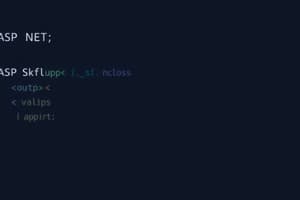Podcast
Questions and Answers
What is the primary purpose of input validation in software applications?
What is the primary purpose of input validation in software applications?
- To improve application performance
- To prevent unauthorized input and security vulnerabilities (correct)
- To enhance user interface design
- To streamline coding processes
Which type of validation checks that data adheres to a specified format or template?
Which type of validation checks that data adheres to a specified format or template?
- Range validation
- Type validation
- Syntactic validation (correct)
- Semantic validation
What does an input validation attack typically involve?
What does an input validation attack typically involve?
- Sending overly large data packets
- Using encryption to secure input data
- Entering data into a program for testing purposes
- Deliberately submitting malicious data to exploit vulnerabilities (correct)
What is the significance of an allow list in input validation?
What is the significance of an allow list in input validation?
According to a secure implementation overview, what type of issues primarily affect security?
According to a secure implementation overview, what type of issues primarily affect security?
What does a format check in input validation ensure?
What does a format check in input validation ensure?
What is the primary function of an input mask?
What is the primary function of an input mask?
What are some common types of input validation checks?
What are some common types of input validation checks?
Which type of validation ensures that a start date does not come after an end date?
Which type of validation ensures that a start date does not come after an end date?
What does range validation check?
What does range validation check?
Which type of validation checks whether the input is within defined limits?
Which type of validation checks whether the input is within defined limits?
What is a potential outcome of failing to implement proper input validation?
What is a potential outcome of failing to implement proper input validation?
What is a characteristic of allow list validation?
What is a characteristic of allow list validation?
Which of the following would NOT be considered a good practice in input validation?
Which of the following would NOT be considered a good practice in input validation?
What is a key benefit of performing a length check on input data?
What is a key benefit of performing a length check on input data?
Which validation type requires knowledge of all potential attack patterns?
Which validation type requires knowledge of all potential attack patterns?
What type of checks ensure that a telephone number has exactly 10 digits?
What type of checks ensure that a telephone number has exactly 10 digits?
What is one method to validate whether a numeric value is valid for a specific context?
What is one method to validate whether a numeric value is valid for a specific context?
In input validation, what is the purpose of performing a reasonable check?
In input validation, what is the purpose of performing a reasonable check?
Which of the following is not a reason to use input validation?
Which of the following is not a reason to use input validation?
Flashcards
Input Validation
Input Validation
Checking user input to prevent security vulnerabilities and errors.
Input Validation Attack
Input Validation Attack
An attack where malicious input is provided to exploit application vulnerabilities.
Syntactic Validation
Syntactic Validation
Checking if user input follows the correct structure.
Format Check
Format Check
Signup and view all the flashcards
Allow List
Allow List
Signup and view all the flashcards
Block (Deny) List
Block (Deny) List
Signup and view all the flashcards
Semantic Validation
Semantic Validation
Signup and view all the flashcards
Input Validation Implementation
Input Validation Implementation
Signup and view all the flashcards
Common Software Vulnerabilities
Common Software Vulnerabilities
Signup and view all the flashcards
Secure Coding
Secure Coding
Signup and view all the flashcards
Input Mask
Input Mask
Signup and view all the flashcards
Length Validation
Length Validation
Signup and view all the flashcards
Type Validation
Type Validation
Signup and view all the flashcards
Data Size Checks
Data Size Checks
Signup and view all the flashcards
Range Validation
Range Validation
Signup and view all the flashcards
Allow List Validation
Allow List Validation
Signup and view all the flashcards
Deny List Validation
Deny List Validation
Signup and view all the flashcards
Reasonable Check
Reasonable Check
Signup and view all the flashcards
Study Notes
CSC 1029 Input Validation
-
Objectives: Identify and describe secure coding implementation. Apply secure coding principles based on industry coding standards. Identify common software vulnerabilities.
-
Agenda (Week 09):
- Input Validation Definitions
- Input Validation (Format, Length, Type, Range)
- Allow List and Deny List
- Handling input errors
- Demo
- TODO
- Resources for Help
OWASP Input Validation Cheat Sheet
- Review the article to define:
- Syntactic Validation
- Semantic Validation
- Allow List
- Block (Deny) List
Secure Implementation Overview
- Microsoft noted only two types of security implementation issues:
- Input validation
- Everything else
Input Validation Defined
- Any program input (e.g., user typing, network connection) can be a source of security vulnerabilities and bugs.
- Treat all input as potentially dangerous.
- Prevent attacks as early as possible in processing user requests.
- Use input validation to detect unauthorized input before processing.
What is Input Validation Attack?
- An attacker deliberately enters malicious input to confuse an application and cause unplanned actions.
- Malicious input can include code, scripts, and commands that exploit vulnerabilities if not validated correctly.
Input Validation: Format/Syntactic
- Syntactic validation enforces correct syntax of structured fields (e.g., SSN, dates, currency symbols).
- Format check ensures data is in a specified format (template), like mm/dd/yyyy for dates.
- Input mask uses special characters to indicate where specific characters can be typed.
Input Validation: Length/Semantic
- Semantic validation ensures data correctness in a business context (e.g., start date before end date, price within range).
- Length checking ensures variables have the appropriate length (e.g., US phone numbers have 10 digits).
Input Validation: Type
- Check if the data type is correct (e.g., numeric, positive number).
- Check data size to verify string lengths and numeric accuracy (e.g., integer size).
- Often recommended to initially enter data as a string and then validate before converting it to another data type.
Input Validation: Range
- Range checking ensures numbers are within a specific range (e.g., months 1-12).
- Reasonable checking verifies values match expectations (e.g., age between 16 and 100).
Allow List
- Allow list validation (also called inclusion or positive validation) is appropriate for all user-provided input.
- It defines what input is authorized, and everything else is blocked.
- Compare input data against expected formats, lengths, types, and ranges.
- Reject any data that doesn't match.
Deny List/Block List
- Deny list validation (also called exclusion or negative validation) requires knowledge of all possible attack patterns (difficult).
- It's a common mistake to use a deny list to try detecting dangerous characters.
- It is a flawed approach as it is easy for attackers to bypass filters.
- It defines what is blocked, with everything else allowed.
Input Validation Format & Length Demo
- "All input is evil, until proven otherwise."
- Garbage in, garbage out.
- Validate input that crosses trust boundaries.
- Validate inputs against expected data: format, length, type, range.
Input Validation Type & Range Demo
- Verify data content matches expected type (e.g., a ZIP code).
- Ensure data contains only expected characters for the data type (e.g., allowed punctuation in a name).
Input Validation Defense-in-Depth
- Input validation is a valuable security tool.
- It should be part of a broader defense-in-depth strategy.
- Multiple layers of defense are necessary for overall application security.
What to Do When Input Fails
- Recovery and Continuing: Recover from input validation failure by sanitizing or fixing the input problem programmatically.
- Failing the Action and Reporting an Error: Disadvantage is that the user experience is interrupted and any in-progress transaction may be lost.
References
- Microsoft Secure Implementation Principles
- Cybersecurity Modules: Security Injections
- Input Validation Cheat Sheet
- Application Security Terminology
- Science Direct - Input validation
TODO
- Post weekly discussion question and research solution to D2L.
- Complete Week 09 Content Module in D2L to 100%.
Help/Questions
- Student Office Hours (by appointment or drop-in)
- Email: [email protected]
- RRCC On-Campus Tutoring
- 24/7 online tutoring (via D2L)
Studying That Suits You
Use AI to generate personalized quizzes and flashcards to suit your learning preferences.




